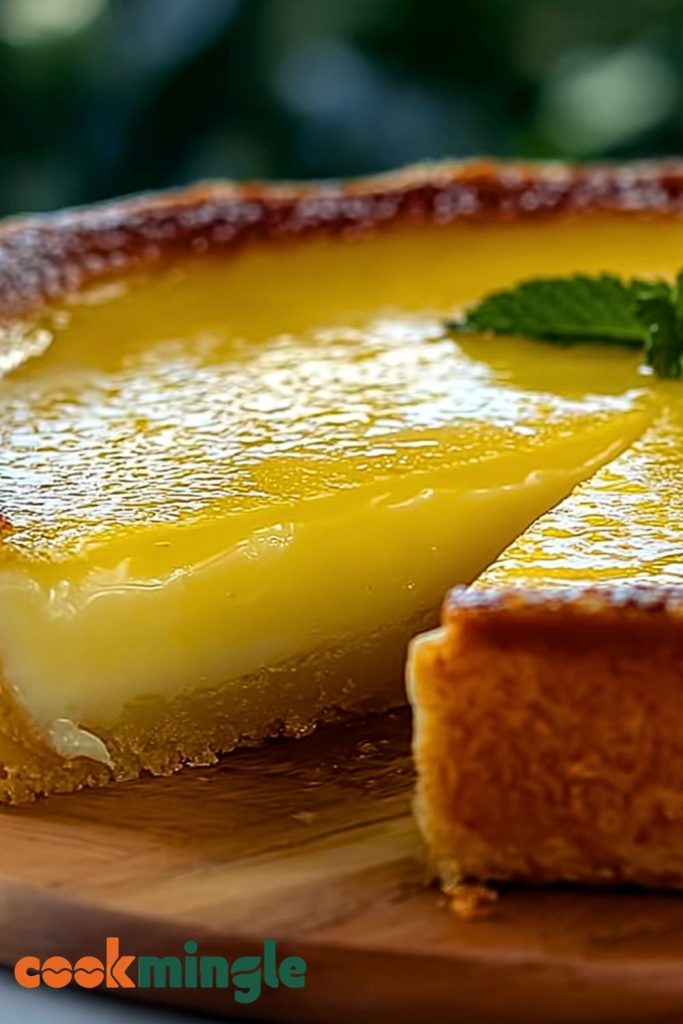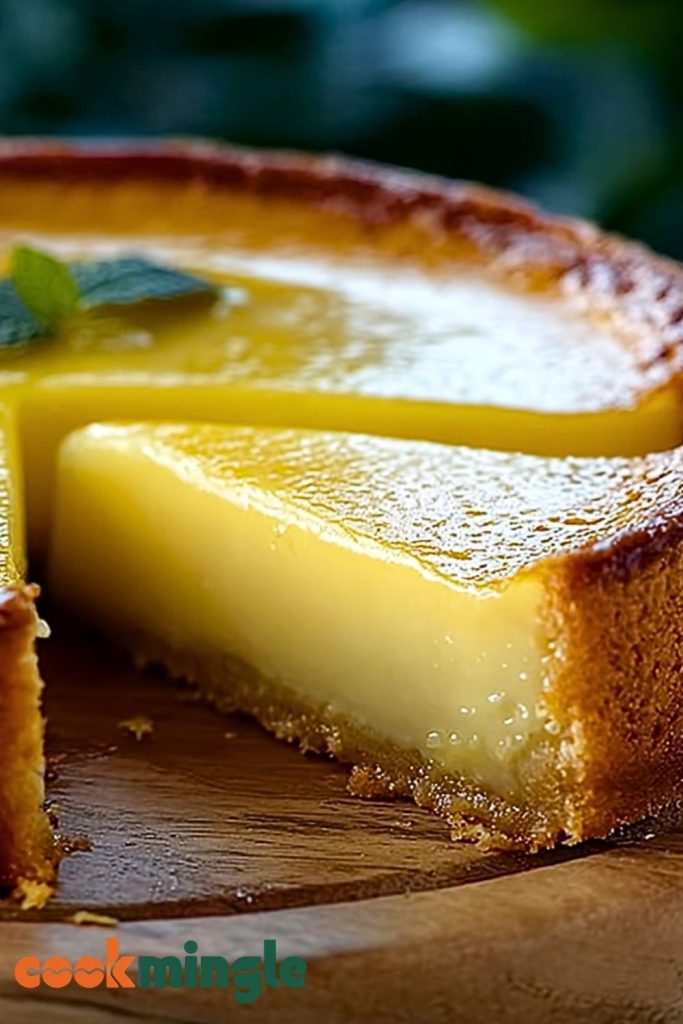There’s something undeniably comforting about the soft texture and bright flavor of a lemon dessert — especially when it’s layered into a silky custard and held together with a golden, buttery crust. This Refreshing Italian Lemon Custard Cake has quickly become one of my favorite go-to recipes when I want to serve something that’s elegant, zesty, and impossible to resist. It’s like a slice of sunshine on a plate, perfect for spring brunches, light summer desserts, or just an afternoon pick-me-up with tea.

What I love most about this cake is the balance — the vibrant lemon flavor doesn’t overwhelm; instead, it lingers on the palate with a creamy richness that feels indulgent but never heavy. I’ve tested several versions over the years, and this one nails that authentic Italian flair. The custard is smooth and bright, and the base gives it just the right structure without stealing the spotlight. Whether you’re baking it for guests or just to treat yourself, this cake will leave everyone asking for the recipe.
Why You’ll Love This Refreshing Italian Lemon Custard Cake
This cake is a celebration of contrasts — cool yet rich, simple but refined. The custard is silky, sweetened just enough to balance the tang of fresh lemon juice, and poured into a delicate crust that holds its shape with a gentle crunch. It’s a crowd-pleaser that looks stunning but doesn’t demand hours in the kitchen. You don’t need to be an expert baker to master it — and once you taste that first bite, you’ll understand why this has become a staple in so many Italian homes.
What Kind of Crust Should I Use for Italian Lemon Custard Cake?
For this custard cake, the crust plays a subtle but important role. I personally prefer a classic cookie crumb crust, made with crushed digestive biscuits or graham crackers, a touch of sugar, and melted butter. It bakes up with a golden edge that contrasts beautifully with the smooth lemon filling.
Alternatively, a sweet shortcrust pastry (pasta frolla) adds a more traditional Italian touch. It’s slightly firmer, offering more structure, and has a tender, cookie-like texture that complements the custard well. If you’re short on time, even a pre-made tart shell can work in a pinch — just make sure it’s not too thick or overpowering in flavor.
Options for Substitutions
Whether you’re adjusting for dietary needs or simply out of an ingredient, this cake offers some flexibility without losing its charm:
- Lemon Juice: Fresh lemon juice is key, but if you’re in a bind, bottled 100% lemon juice works — though it won’t have the same brightness.
- Butter: Swap with plant-based butter if you’re keeping it dairy-free. It still gives the crust richness.
- Sugar: You can use coconut sugar or a sugar substitute like erythritol, though it will slightly alter the flavor and color.
- Milk: Whole milk gives the best creamy texture, but you can substitute with almond or oat milk for a lighter version.
- Eggs: For an egg-free custard, try cornstarch-thickened lemon pudding instead. It won’t be quite the same, but it works for a vegan adaptation.
Ingredients for This Refreshing Italian Lemon Custard Cake
Each ingredient in this recipe plays a specific role in creating that luxurious, bright flavor and creamy texture. Let’s take a closer look at what you’ll need and why:
- Digestive Biscuits or Graham Crackers: Crushed into fine crumbs, these form the base of the crust, adding a gentle sweetness and crumbly texture.
- Unsalted Butter: Melted butter binds the crumbs together and gives the crust its golden, rich flavor.
- Granulated Sugar: Sweetens both the crust and custard, helping balance the tartness of the lemons.
- Whole Milk: Provides the custard with creaminess and body without making it too heavy.
- Egg Yolks: Essential for thickening the custard and giving it that signature silky, rich texture.
- Cornstarch: Helps stabilize the custard, giving it just the right firmness to slice cleanly.
- Fresh Lemon Juice: The star of the show — brings brightness and that unmistakable citrus punch.
- Lemon Zest: Adds an aromatic depth and intensifies the lemon flavor.
- Vanilla Extract: A small splash enhances the custard’s overall flavor with a warm, rounded note.
- Salt: Just a pinch to balance the sweetness and deepen the flavors.

Step 1: Prepare the Crust
Start by preheating your oven to 350°F (175°C). In a mixing bowl, combine the crushed digestive biscuits or graham crackers with melted butter and a bit of sugar. Stir until the crumbs are evenly coated and resemble wet sand. Press the mixture firmly into the bottom and slightly up the sides of a springform pan or tart pan. Bake the crust for about 10 minutes, until it turns golden and fragrant. Let it cool while you prepare the custard.
Step 2: Heat the Milk
In a medium saucepan, warm the whole milk over medium heat until it’s hot but not boiling — small bubbles should form around the edges. Remove from heat and set aside.
Step 3: Whisk the Egg Yolks and Sugar
In a large bowl, whisk the egg yolks with sugar until the mixture is pale and slightly thickened. Add in the cornstarch and a pinch of salt, whisking until smooth and no lumps remain.
Step 4: Temper the Eggs
Slowly pour the warm milk into the egg mixture, whisking constantly to prevent the eggs from curdling. Once combined, pour everything back into the saucepan and return to medium-low heat.
Step 5: Cook the Custard
Stir the mixture continuously with a wooden spoon or silicone spatula until it thickens to a pudding-like consistency. This usually takes 5–8 minutes. Once thickened, remove from heat and stir in the lemon juice, lemon zest, and vanilla extract.
Step 6: Assemble the Cake
Pour the warm lemon custard into the cooled crust. Use a spatula to smooth the top evenly. Gently tap the pan on the counter to release any air bubbles.
Step 7: Chill and Set
Place the assembled cake in the refrigerator for at least 4 hours, or overnight if possible. This will allow the custard to fully set and the flavors to develop beautifully.
How Long to Cook the Refreshing Italian Lemon Custard Cake
This cake doesn’t require traditional baking beyond the crust — the magic happens on the stovetop and in the fridge. Here’s the timing breakdown:
- Crust Bake Time: 10 minutes at 350°F (175°C) until golden.
- Custard Cooking Time: 5–8 minutes over medium-low heat to thicken.
- Chill Time: Minimum of 4 hours in the refrigerator (overnight is ideal for the best texture).
The actual cooking is quick, but the key to perfection lies in the chilling — don’t rush it. The custard needs time to firm up and settle into that velvety, sliceable consistency.
Tips for Perfect Lemon Custard Cake
- Use Fresh Lemons: Bottled juice lacks the zest and brightness of fresh citrus. Zest your lemons before juicing to capture all that fragrant oil.
- Strain the Custard: If you want a super-smooth finish, strain the custard through a fine mesh sieve before pouring it into the crust. This removes any lumps or cooked egg bits.
- Don’t Overcook the Custard: Once it thickens to a pudding-like texture, take it off the heat. Overcooking can make it grainy or cause it to split.
- Chill Completely: Allow a full chill time. Cutting too soon can ruin the texture and make it ooze.
- Use a Springform Pan: It makes releasing the cake cleaner and easier — especially when serving guests.
Watch Out for These Mistakes While Cooking
Even with simple steps, a few missteps can throw off the final result. Here’s what to avoid when making your Refreshing Italian Lemon Custard Cake:
- Skipping the Tempering Step: Adding hot milk directly to eggs without tempering can scramble them. Always pour slowly while whisking.
- Not Cooking the Custard Long Enough: Undercooked custard will be too runny and won’t set properly in the fridge.
- Overbaking the Crust: It should be lightly golden, not dark brown. An overbaked crust can turn too hard once chilled.
- Using Cold Ingredients: For a silky custard, bring eggs and milk close to room temperature before mixing.
- Not Chilling Long Enough: Cutting into the cake too early will result in a messy, unset custard. Let it firm up fully.
- Forgetting to Stir Constantly: During custard cooking, you need to keep stirring to prevent it from sticking or curdling.
What to Serve With Refreshing Italian Lemon Custard Cake?
This cake is lovely on its own, but pairing it with the right sides or drinks makes it even more memorable. Try one or more of these for a well-rounded dessert experience:
Whipped Mascarpone
A dollop of lightly sweetened mascarpone cream adds richness and keeps with the Italian theme.
Fresh Berries
Strawberries, blueberries, or raspberries balance the tart lemon with juicy freshness and a pop of color.
Limoncello Shots
For an adults-only pairing, serve small glasses of chilled limoncello for a citrusy complement.
Light Sparkling Wine
Something like Prosecco or Moscato d’Asti pairs beautifully without overpowering the dessert.
Mint Tea or Green Tea
Their herbal brightness contrasts nicely with the custard and helps cleanse the palate.
Almond Biscotti
Offer a crunchy element on the side to contrast with the creamy texture of the cake.
Lemon Curd Drizzle
For citrus lovers, a swirl of lemon curd over each slice adds more tang and a glossy finish.
Storage Instructions
One of the best things about this Refreshing Italian Lemon Custard Cake is that it stores beautifully — in fact, it gets even better the next day. Here’s how to keep it fresh:
- Refrigerator: Store the cake covered (use plastic wrap or an airtight container) for up to 4 days. Keep it chilled at all times since the custard is dairy-based and needs to stay cold to maintain texture and food safety.
- Freezer: You can freeze it, but it’s best to freeze individual slices. Wrap them tightly in plastic wrap and foil, then place in a freezer-safe container. It will keep for up to 1 month. Thaw overnight in the fridge before serving.
- Do Not Leave Out: Because of the custard, this cake should not sit out at room temperature for more than 1–2 hours.
Estimated Nutrition
Please note, these values are estimates based on a standard 9-inch cake cut into 10 slices. The actual numbers may vary depending on specific ingredients used:
- Calories: ~280 per slice
- Total Fat: 14g
- Saturated Fat: 8g
- Cholesterol: 125mg
- Sodium: 95mg
- Carbohydrates: 33g
- Sugar: 20g
- Fiber: 1g
- Protein: 5g
This dessert strikes a balance — indulgent yet not overwhelming. You get that creamy satisfaction without the heaviness of a typical cheesecake or dense tart.
Frequently Asked Questions
What’s the difference between this and a lemon tart?
Great question! While both use lemon custard, a lemon tart typically has a firmer, more curd-like texture and a thinner crust. This Italian version is creamier, with a softer custard that’s more pudding-like, and a gentler flavor.
Can I make this cake ahead of time?
Absolutely. In fact, it’s even better when made a day ahead. The flavors settle, and the custard sets more firmly, making it easier to slice and serve.
Can I use bottled lemon juice instead of fresh?
You can, but I don’t recommend it unless you have no choice. Fresh lemon juice gives a much brighter and cleaner flavor, while bottled can taste dull or slightly metallic.
How do I know when the custard is done cooking?
Once it thickens to a pudding-like consistency and coats the back of a spoon, it’s done. Avoid overcooking — if it starts to bubble or clump, it’s gone too far.
Is this cake gluten-free?
Not as written, since the crust uses traditional biscuits or crackers. However, you can substitute with gluten-free cookies to make it entirely gluten-free.
Can I use a store-bought crust?
Yes, if you’re short on time! Just make sure it’s not overly sweet or flavored, as it might clash with the lemon custard.
What if my custard has lumps?
It happens! Simply strain the custard through a fine mesh sieve before pouring it into the crust. This will give you a perfectly smooth finish.
Can I double the recipe for a larger crowd?
You can, but instead of doubling everything in one pan, it’s better to make two separate cakes to ensure even setting and baking. Custard can be tricky in large volumes.
Conclusion
This Refreshing Italian Lemon Custard Cake is a dessert that brings light, elegance, and just enough indulgence to any table. Whether you’re planning a weekend brunch, celebrating a birthday, or just treating yourself to something special, this cake is a joyful nod to Italian simplicity — where quality ingredients shine and every bite feels like a little sunshine. It’s easy to love, easier to make than you’d expect, and guaranteed to disappear fast.

Refreshing Italian Lemon Custard Cake
- Total Time: 4 hours 30 minutes
- Yield: 10 slices
- Diet: Vegetarian
Description
Looking for the perfect balance between citrusy brightness and creamy indulgence? This Refreshing Italian Lemon Custard Cake delivers on all fronts — a smooth, silky custard infused with fresh lemon juice and zest, layered over a buttery, golden crust. It’s a standout among easy desserts, ideal for brunch, light summer dinners, or when you’re craving a healthy snack with a touch of luxury. It’s also one of those versatile breakfast ideas that doubles beautifully as a refined treat. Whether you’re new to baking or a seasoned pro, this easy recipe will impress with both flavor and elegance.
Ingredients
150 grams digestive biscuits or graham crackers
70 grams unsalted butter, melted
2 tablespoons granulated sugar (for crust)
500 milliliters whole milk
4 large egg yolks
100 grams granulated sugar (for custard)
2 tablespoons cornstarch
1 tablespoon lemon zest
80 milliliters fresh lemon juice
1 teaspoon vanilla extract
1 pinch salt
Instructions
1. Preheat your oven to 350°F (175°C).
2. In a bowl, mix crushed biscuits with melted butter and 2 tablespoons sugar.
3. Press the mixture into the base of a springform or tart pan to form an even crust.
4. Bake the crust for 10 minutes or until golden. Set aside to cool.
5. In a saucepan, warm the milk over medium heat until hot but not boiling.
6. In a separate bowl, whisk egg yolks with 100g sugar until pale. Add cornstarch and salt.
7. Slowly pour the warm milk into the egg mixture while whisking continuously to temper.
8. Return the entire mixture to the saucepan and cook over medium-low heat, stirring constantly.
9. Cook for 5–8 minutes until thickened to a pudding-like consistency.
10. Remove from heat and stir in lemon juice, lemon zest, and vanilla extract.
11. Pour the warm custard into the cooled crust and smooth the top.
12. Refrigerate for at least 4 hours or overnight until fully set.
13. Slice and serve chilled.
Notes
Use a fine mesh strainer to get a silky-smooth custard texture.
Always zest your lemons *before* juicing to make sure you don’t waste the flavorful oils.
For easier serving, use a springform pan and run a warm knife around the edge before slicing.
- Prep Time: 20 minutes
- Cook Time: 10 minutes
- Category: Dessert
- Method: No-bake custard (with baked crust)
- Cuisine: Italian
Nutrition
- Serving Size: 1 slice
- Calories: 280
- Sugar: 20g
- Sodium: 95mg
- Fat: 14g
- Saturated Fat: 8g
- Unsaturated Fat: 5g
- Trans Fat: 0g
- Carbohydrates: 33g
- Fiber: 1g
- Protein: 5g
- Cholesterol: 125mg

